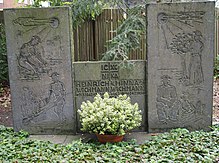Heinrich Wichmann (architect)
Heinrich Wichmann (born May 16, 1898 in Celle ; † April 8, 1962 ) was a German architect , project developer and building contractor .
Life
Heinrich Wichmann was born in Celle on May 16, 1898 as the son of a gardener family, whose "art and commercial gardening" was founded shortly before in 1897 by the entrepreneur of the same name, Heinrich Wichmann, at Tannholzweg 1-3 .
Around 1920/1925 Wichmann went to Berlin , where he worked in the office of the architect Peter Behrens .
In 1926 Heinrich Wichmann set up his own architecture office in Weimar , where he worked according to the ideas of the Bauhaus . In 1927 he moved to Dresden , where he designed cinemas, administrative buildings, large catering and industrial facilities, especially in central Germany.
In 1929 Wichmann was elected to the board of regional group IV (Saxony) of the Association of German Architects .
After winning an architectural competition , Wichmann redesigned the Stadtsparkasse Celle from 1934–1935 .
Wichmann founded the Lausitz construction company on August 28, 1936 in Bautzen . The founding contract was signed by Wichmann and the master craftsmen and builders working there Heinrich Mirtschin, Richard Hummitzsch, Max Blümel, Gerhard Putschke, Richard Sommer, August Kielmann, Manfred Adler, Alfred Straßburger, Kurt Malschie, Georg Wiegand and Josef Patzek. This company formed the beginning of the later Wichmann group of companies and built numerous apartments up to the beginning of the Second World War . In particular, the Spittelwiese settlement built in Bautzen in 1936 developed into a model settlement for Saxony .
In the years from 1952 to 1954 he founded the Regie- und Wirtschaftsbau company, organized as a GmbH . Wichmann's demands for rationalization , mechanization and typification initially met with massive resistance from the entrepreneurs and craftsmen involved in the construction . However, due to the lack of living space in Celle, Wichmann made a name for himself less as a representative of New Building , but as a champion of the “functionalism of the construction industry” of the 1950s and 1960s and finally as one of the great post-war housing pioneers in Celle.
In 1958, the Mobil-Oil high-rise , built according to Wichmann's plans in Celle, was inaugurated, which is considered the first high-rise in the Lüneburg Heath area.
Heinrich Wichmann died on April 8, 1962. The high-rise buildings he designed on Lauensteinplatz and Vorwerker Platz in Celle were posthumously completed in 1962 and 1963.
After the company's founder died in 1965, the Wichmann Group received its later legal form with the parent company Wichmann GmbH & Co. KG and the subsidiaries Regiebau GmbH (founded in 1936) and Wirtschaftsbau GmbH (founded in 1954).
Other buildings (selection)
- For the listed primary school An der Masch in Lehrte , at the second school building at the address An der Masch 2 , also known as "Elementary School I" and "Elementary School I"
- 1955: First extension building;
- 1964–1965: Second extension
literature
- HA Fritzsche (introduction): H. Wichmann. (= Neue Werkkunst ), FE Hübsch, Berlin / Leipzig 1929. ( reprinted with a foreword by Hans-Georg Lippert and an essay by Tanja Scheffler: Gebrüder Mann, Berlin 2020, ISBN 978-3-7861-2790-1 )
- The first high-rise in Celle. Inauguration of the new office building of the crude oil department of Mobil Oil. In: Cellesche Zeitung of August 2, 1958, p. 8.
- Wichmann Group (ed.), Klaus Drögemüller: 1936–2011. Living under Wichmann's roofs. (Anniversary publication for the 75th anniversary of the Wichmann Group) Celle 2011, passim . ( online as PDF )
Web links
- oV : Wichmann. Celle's largest private housing provider, with a "radio interview with Heinrich Wichmann on the inauguration of the Celler MobilOil high-rise on August 1st, 1958" on the website wichmann-gruppe.de
Individual evidence
- ↑ a b c d e f g h i j k Klaus Drögemüller: 1936 - 2011. Living under Wichmanns roofs , anniversary publication for the 75th anniversary of the Wichmann Group, publisher: Wichmann Group, Celle 2011, passim; downloadable as a PDF document from wichmann-gruppe.de
- ↑ a b c d e f g h i o. V .: Wichmann. Celle's largest private housing provider on the website wichmann-gruppe.de [ undated ], last accessed on July 8, 2017
- ↑ RWLE Möller , Bernd Polster : Wichmann. In: Celle. The city book. ES, Bonn 2003, ISBN 3-00-012605-8 , p. 252
- ↑ Carolin Krumm (editing), Anne-Kathrin Fricke-Hellberg (collaborator), Peter F. Lufen, Dietmar Vonend (editing) et al. : Matthäuskirche in dies .: Monument topography Federal Republic of Germany , architectural monuments in Lower Saxony , Volume 13.2: Region Hannover. Northern and eastern part with the cities of Burgdorf, Garbsen, Langenhagen, Lehrte, Neustadt a. Rbge., Sehnde, Wunstorf and the communities of Burgwedel, Isernhagen, Uetze and Wedemark , edited by Christiane Segers-Glocke , Hameln: CW Niemeyer Buchverlage GmbH, 2005, ISBN 3-8271-8255-7 , pp. 282–286; here: p. 283f .; as well as overview and map of the city of Lehrte , p. 112f. and List of Monuments p. 585f.
- ↑ Compare the inscription on the information board attached to the building by the city of Lehrte and the Verein Stadtmarketing Lehrte eV and further information on the QR code on the memorial boards (3)
| personal data | |
|---|---|
| SURNAME | Wichmann, Heinrich |
| BRIEF DESCRIPTION | German architect, project developer and building contractor |
| DATE OF BIRTH | May 16, 1898 |
| PLACE OF BIRTH | Celle |
| DATE OF DEATH | April 8, 1962 |



